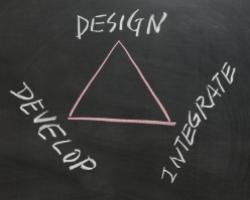When people think about design they often visualize Apple’s products or a user interface. But design in IT is much more than that. While many pieces of an overall lifecycle are concerned with design tasks, say like the UI, the process itself is also driven by the need to create functional systems. This holds true for both hardware and software, as well as complex enterprise initiatives like ERP or even cyber security. If we consider "design" as a verb—the activity that produces something—then "architecture" is the noun that design creates. "Integrated design" represents the ability to conduct design activities within a uniform enterprise context. To get a better sense as to how integrated design is applied, let's look at some typical enterprise IT projects. In projects such as a legacy migration or an ERP transformation, you're likely to find the following types of design activities:
- Enterprise architecture
- Data modeling
- Data architecture design
- Business process modeling
- User interface design
- User experience design (and yes, this is somewhat different from interface design as user experience crosses platforms and technologies these days)
- Application and service design
- Infrastructure and/or network design
These tasks are generally vital to the success of an overall project, yet many if not most of them happen in design "stovepipes." The concept of Integrated Design is similar to how some people view Enterprise Architecture except that Integrated Design is less focused on formal frameworks or specific EA tools. In other words, it's more likely to provide an all-encompassing umbrella for all types of design activity. For example, some people might not consider a detailed network design or data center design to be part of enterprise architecture, although others might—there is no standard definition or boundary. Integrated design, however, is a more flexible, perhaps even an Agile way to tackle what is in fact one of the biggest challenges most enterprises face today: complexity. The complexity we're referring to is the ability to reconcile and align all of the various designs (and design activities) associated with a complex enterprise or specific enterprise initiative into a single solution using a unified lifecycle management framework. There are three simple principles behind integrated design:
- All design activities ought to share the same lifecycle methodology and automation framework. Integrating models or architectures can sometimes be referred to as meta-integration, and as the name implies, it represents an added layer of complexity to an already complex project. A shared automation framework does not have to be an EA tool.
- All designs must be targeted to the shared capabilities. There are finite sets of capabilities associated with any given solution. By pegging or mapping each design to its relevant solution capabilities, we achieve and maintain automatically a certain level of integration.
- All design (on the project or within the solution) is related. While some designs may only be complementary rather than dependent, all designs and thus all later functionality have relationships to one another. Understanding those relationships up front is perhaps the greatest risk-reduction technique available in IT today. These relationships are both broad and narrow in nature (and can extend down to the data element level).
Design is and always will be a creative endeavor. However, if we keep in mind the principles of integrated design, we can see how that creativity can be merged along with systems engineering to produce innovative and successful solutions. Image:
Design, Develop and Integrate [Bigstock]
